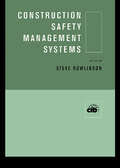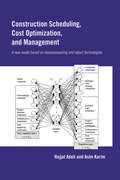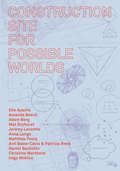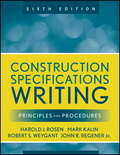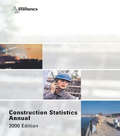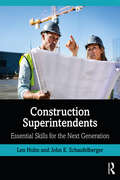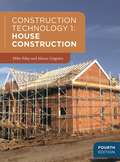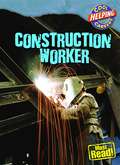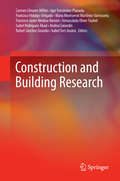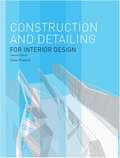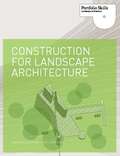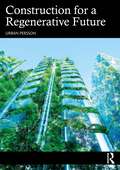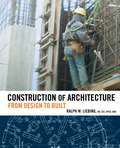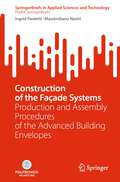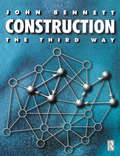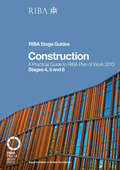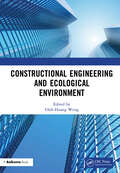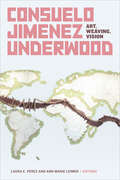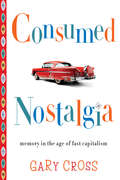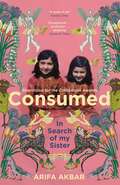- Table View
- List View
Construction Safety Management Systems
by Steve RowlinsonThe construction industry has a distressingly poor safety record, whether measured in absolute terms or alongside other industries. The level of construction safety in a country is influenced by factors such as variations in the labour forces, shifting economies, insurance rates, legal ramifications and the stage of technological development. Yet the problem is a world-wide one, and many of the ways of tackling it can be applied across countries. Effective tools include designing, preplanning, training, management commitment and the development of a safety culture. The introduction and operation of effective safety management systems represents a viable way forwards, but these systems are all too rarely implemented. How can this be done? Should we go back to prescriptive legislation? This book considers these questions by drawing together leading-edge research papers from the proceedings of an international conference conducted by a commission (W099) on Safety and Health on Construction Sites of CIB, the international council of building research organisations.
Construction Scheduling, Cost Optimization and Management
by Hojjat Adeli Asim KarimConstruction Scheduling, Cost Optimization and Management presents a general mathematical formula for the scheduling of construction projects. Using this formula, repetitive and non-repetitive tasks, work continuity considerations, multiple-crew strategies, and the effects of varying job conditions on the performance of a crew can be modelled. This book presents an entirely new approach to the construction scheduling problem. It provides a practical methodology which will be of great benefit to all those involved in construction scheduling and cost optimization, including construction engineers, highway engineers, transportation engineers, contractors and architects. It will also be useful for researchers, and graduates on courses in construction scheduling and planning.
Construction Site for Possible Worlds
by Matthew Poole Robin Mackay Amanda Beech Adam Berg Mat Dryhurst Jeremy Lecomte Anna Longo Anil Bawa-Cavia Patricia Reed Daniel Sacilotto Christine Wertheim Inigo WilkinsPerspectives from philosophy, aesthetics, and art on how to envisage the construction site of possible worlds. Given the highly coercive and heavily surveilled dynamics of the present moment, when the tremendous pressures exerted by capital on contemporary life produces an aggressively normative “official reality,” the question of the construction of other possible worlds is crucial and perhaps more urgent than ever.T his collection brings together different perspectives from the fields of philosophy, aesthetics, and art to discuss the mechanisms through which possible worlds are thought, constructed, and instantiated, forcefully seeking to overcome the contemporary moment's deficit of conceptualizing alternate realities—its apparent fear of imagining possible new and compelling futures—to begin the arduous task of producing the political dynamics necessary for actual construction.Implicit in this dynamic between the imaginary and the possible is the question of how thinking intertwines with both rationality and the inherited contingencies and structures of the world. With no ascertainable ground on which to build, with no confidence in any given that could guarantee our labors, how do we even envisage the construction site(s) of possible worlds, and with what kind of diagrams, tools, and languages can we bring them into being?
Construction Specifications Writing
by Robert S. Weygant Mark Kalin John R. Regener Harold J. RosenUpdated edition of the comprehensive rulebook to the specifier's craftWith this latest update, Construction Specifications Writing, Sixth Edition continues to claim distinction as the foremost text on construction specifications. This mainstay in the field offers comprehensive, practical, and professional guidance to understanding the purposes and processes for preparation of construction specifications.This new edition uses real-world document examples that reflect current writing practices shaped by the well-established principles and requirements of major professional associations, including the American Institute of Architects (AIA), the Engineers Joint Contract Documents Committee (EJCDC), and the Construction Specifications Institute (CSI). Also included are guidelines for correct terminology, product selection, organization of specifications according to recognized CSI formats, and practical techniques for document production. Fully revised throughout, this Sixth Edition includes:Updates to MasterFormat 2004, as well as SectionFormat/PageFormat 2007 and UniformatEnd-of-chapter questions and specification-writing exercisesSamples of the newly updated construction documents from the AIANew chapter on sustainable design and specifications for LEED projectsUpdated information on the role of specifications in Building Information Modeling (BIM)
Construction Statistics Annual, 2000
by Department of the Environment, Transport and the RegionsThis is the first edition of the Construction Statistics Annual presenting a comprehensive set of statistics on the UK construction industry, current as of Summer 2000. In previous years the corresponding information was presented as the Digest of Data for the Construction Industry and as the construction part of Housing and Construction Statistics, but it replaces these and brings the material together in a single volume. This 2000 Edition of the Construction Statistics Annual gives a broad perspective of statistical trends in the construction industry in Great Britain through the last decade together with some international comparisons and features on leading initiatives which may influence the future. This new compendium provides essential, official, in-depth statistical analysis for planners, researchers, economists and construction managers.
Construction Superintendents: Essential Skills for the Next Generation
by John E. Schaufelberger Len HolmConstruction Superintendents: Essential Skills for the Next Generation is the first college-level textbook designed to prepare you to take on a site supervisor role on a complex jobsite. The book covers the responsibilities of superintendents in relation to the jobsite project management team, the project owners, designers, and municipal services. The book outlines the development of the superintendent and his or her role and responsibilities in twenty-first century construction projects. Using examples and case studies of cutting-edge jobsite practices from the use of computer applications to leadership and capital development, this book lays out all the functions of a modern site superintendent in an easy-to-understand format. The book includes: coverage of the full spectrum of tasks and skills required from the pre-construction phase, through start-up, operation and close-out, plus advanced topics for those serious about leading the field real-world case studies, forms, and documentation stored on a companion website chapter summaries, review questions, and exercises to aid both teaching and learning. This book fills in the long-standing need for an academic textbook designed as an applied instructional resource suitable for university and college students enrolled in construction management and construction engineering programmes.
Construction Technology 1: House Construction
by Mike Riley Alison CotgraveConstruction Technology 1: House Construction offers a highly accessible introduction to the key stages of domestic house construction from planning to internal finishes. Its student-friendly layout uses detailed figures, photos and case studies from real-life building sites to aid a practical understanding of construction techniques, providing clear step-by-step guidance in learning the basic principles of low-rise residential construction. This textbook is a vital resource for students in construction, property and architecture, BSc and MSc, including any student taking courses in building surveying, quantity surveying, real estate and construction management, as well as those studying at the HNC/HND level.
Construction Worker (Cool Helping Careers)
by Geoffrey M. HornConstruction Worker: Working in construction means much more than strapping on a tool belt and a hard hat. Careers in the building trades use cutting-edge methods to make the world's tallest skyscrapers, deepest tunnels, biggest stadiums, and most energy-efficient homes. In this exciting book, students follow the progress of a building - and the people responsible for building it - from the plans to the plaster. Learn how to build a career from the ground up!
Construction and Building Research
by Carmen Llinares-Millán Igor Fernández-Plazaola Francisco Hidalgo-Delgado María Montserrat Martínez-Valenzuela Francisco Javier Medina-Ramón Inmaculada Oliver-Faubel Isabel Rodríguez-Abad Andrea Salandin Rafael Sánchez-Grandia Isabel Tort-AusinaMany areas of knowledge converge in the building industry and therefore research in this field necessarily involves an interdisciplinary approach. Effective research requires strong relation between a broad variety of scientific and technological domains and more conventional construction or craft processes, while also considering advanced management processes, where all the main actors permanently interact. This publication takes an interdisciplinary approach grouping various studies on the building industry chosen from among the works presented for the 2nd International Conference on Construction and Building Research. The papers examine aspects of materials and building systems; construction technology; energy and sustainability; construction management; heritage, refurbishment and conservation. The information contained within these pages may be of interest to researchers and practitioners in construction and building activities from the academic sphere, as well as public and private sectors.
Construction and Detailing for Interior Design Second Edition
by Drew PlunkettConstruction and detailing are vital skills for all students studying interior design and architecture. This book is structured to encourage a diversity of techniques, allowing each student the means to find and put into practice the appropriate solution to fabrication issues and also to express their own personal aesthetic. The relation of existing building shells to the construction and detailing of new elements is also explored. Practical tips are given throughout the book, the roles of consultants, manufacturers, suppliers, and fabricators are explained, and theories of modern, sustainable approaches to interior detailing are discussed. The chapters are packed with professional, annotated drawings and explanatory photographs of techniques, materials, and tools. Through these, the principles of sound construction are explained. This second edition includes revised diagrams to increase clarity, more on sustainability, and more on services and lighting.
Construction and Detailing for Interior Design Second Edition
by Drew PlunkettConstruction and detailing are vital skills for all students studying interior design and architecture. This book is structured to encourage a diversity of techniques, allowing each student the means to find and put into practice the appropriate solution to fabrication issues and also to express their own personal aesthetic. The relation of existing building shells to the construction and detailing of new elements is also explored. Practical tips are given throughout the book, the roles of consultants, manufacturers, suppliers, and fabricators are explained, and theories of modern, sustainable approaches to interior detailing are discussed. The chapters are packed with professional, annotated drawings and explanatory photographs of techniques, materials, and tools. Through these, the principles of sound construction are explained. This second edition includes revised diagrams to increase clarity, more on sustainability, and more on services and lighting.
Construction for Landscape Architecture
by Robert HoldenConstruction for Landscape Architecture covers all aspects of landscape construction, giving a good understanding of building materials and assembly. It is heavily illustrated with specially commissioned, detailed construction drawings and has a strong emphasis on sustainability and good practice. At the end of the book there is an extensive glossary and an appendix of technical information.
Construction for Landscape Architecture (Portfolio Skills)
by Robert Holden Jamie LiversedgeConstruction for Landscape Architecture covers all aspects of landscape construction, giving a good understanding of building materials and assembly. It is heavily illustrated with specially commissioned, detailed construction drawings and has a strong emphasis on sustainability and good practice. At the end of the book there is an extensive glossary and an appendix of technical information.
Construction for a Regenerative Future
by Urban PerssonThis is a book about how to manage the processes involved in a construction project towards a sustainable and regenerative endproduct. It covers key project management concepts and links the construction process to the objectives of UN SDGs and beyond zero carbon emissions throughout the whole project life cycle. This introductory textbook is written from a project manager's perspective including considerations of circular economy throughout the construction process focusing on a regenerative or restorative outcome. The book examines the importance of the type and purpose of a building, circularity and de-construction, the site, the client and its organisation, stakeholder considerations, the project organisation, the procurement of consultants and contractors, project performance during design and construction, project hand-over to the client, and the building's operation and maintenance. It also illustrates how to verify the building using existing environmental certifications, how to calculate carbon emissions, and how to deal with used construction materials from a circular economy perspective. International examples of best practice are included throughout, and the book is structured in a way which students will find engaging and easy to follow. This is an ideal textbook for use on construction, architecture, and engineering programmes where the emphasis must urgently be placed on students fostering regenerative construction solutions in their coming professional life.
Construction of Architecture
by Ralph W. LiebingBuildings don't just appear. While the aesthetics and theory of architecture have their glamour, architecture would not exist without the hands-on, nuts-and-bolts process of construction. Construction of Architecture gives architects, contractors, managers, trade workers, and anyone else involved in a building project a thorough overview of the process of taking or converting a fine design concept from a paper exercise to a finished, full-sized, occupiable and usable building.In an easy-to-read, conversational style, Ralph Liebing distills the often-complex procedures in the construction of architecture into clear, understandable phases. Connecting each phase to the next, he takes you step-by-step from project inception and documentation to code compliance to bidding and the contract through finalization of the project and occupancy of the completed building.This book is enhanced with features such as:Drawings and photographs of the building process.Samples of documents used in construction.A concise narrative of the construction of a typical commercial building, from start to finish.An Instructor Companion Site with an expanded glossary and additional resources.With this primer in hand, every aspiring building professional will have the solid foundation in the concepts and skills needed to bring any building project to fruition, from inception to occupancy.
Construction of the Façade Systems: Production and Assembly Procedures of the Advanced Building Envelopes (SpringerBriefs in Applied Sciences and Technology)
by Ingrid Paoletti Massimiliano NastriThe book explores the advanced façade systems according to the productive and constructive contents, in a cognitive and operative form, as a manual text to provide guidelines for researchers, technicians and professionals. It provides operational guidance for the technological design, production planning and site executive coordination for the realization of façade systems. The analysis deals with the main building elements and technical interfaces. The study of the façade systems, after explaining the anchoring structures and their connections to the load-bearing elements, investigates the criteria for the assembly between the framings. In particular, the book examines the technical interfaces of the main advanced envelope systems with respect to the functional, constructive and applicative coordination procedures of the mullions and transoms framing, of the structural sealant glazing façade system, of the unit façade system, of the suspended façade system and of the double skin façade system. The technical and manual character of the book is also expressed through the analysis of the functional and application procedures of the gaskets with respect to the façade systems in order to prevent the transmission of air and water loads: the analysis focuses on the connections between the framing and the enclosure elements of the envelope, in accordance with the compensation of height differences in order to guarantee impermeability, airtightness and insulation. Then, the book describes the assembly and interface conditions between elements of different composition and production within the façade systems: the examination of the technical interfaces involves the development and application of sealants, based on the loads exerted on the jointing devices, in order to fulfill the requirements of sealing and tightness with respect to mechanical, thermal and hygrometric, water, air and wind stresses. Moreover, the study of the envelope systems examines the methodologies directed toward fulfilling the requirements with respect to the actions caused by fire loads, considering the contents related to both components and connections and fixing surfaces.
Construction the Third Way
by John BennettThis book describes current best practice in managing construction. It is based on case studies of leading practice responding to demands from customers that construction match the value and quality that international competition is forcing on their own businesses. The case studies show that major customers now partner with construction firms to find more efficient ways of working. The resulting best practice adds to these cooperative approaches a drive for efficiency and innovation based on benchmarks of world class performance that empower teams to set themselves competitive targets. So the new approach balances cooperation and competition.This is why Professor John Bennett's book is called ''Construction: The Third Way.'' The third way in modern politics balances the extremes of cooperation and competition in the interests of the whole community. At its best it encourages sustainable economic growth within a fair society. These aims are echoed in leading practice where teams able to balance cooperation and competition deliver better value for their customers and yet earn sustainably higher profits for construction.The new approach requires managers to rethink construction using ideas from fundamental science that see human organizations as self-organizing networks of relationships. This throws new light on the strengths and weaknesses of both competition and cooperation, and provides the basis for a new paradigm to guide key construction decisions. The book describes this background and provides advice about organization structures that are responsive to changing markets and technologies, and construction processes that enable the industry to earch fair profits by providing customers with the levels of value and quality they now demand.
Construction: A Practical Guide to RIBA Plan of Work 2013 Stages 4, 5 and 6 (RIBA Stage Guide)
by Phil HoldenThis is the third in a must-have series of step-by-step guides to using the new RIBA Plan of Work 2013 on your project. Drawing together stages 4, 5 and 6 this book explains what needs to have been achieved for Technical Design to begin, how to achieve success in the construction phase as well as the importance of a comprehensive Handover Strategy.Providing a practical tool to running an efficient project each guide follows the same format leading you through the core tasks at each stage supported by tips, definitions, templates and useful techniques. Five theoretical scenarios are used throughout the guides to illustrate how the Plan of Work can be applied on various project types and sizes including an extension to a house, a new library and a large office building.These guides will provide unrivalled support for practices on all projects – large and small – and across all types of procurement.
Constructional Engineering and Ecological Environment: Proceedings of the 4th International Symposium on Architecture Research Frontiers and Ecological Environment (ARFEE 2022), Guilin, China, 23-25 December 2022
by Chih-Huang WengConstructional Engineering and Ecological Environment contains papers presented at the 4th International Symposium on Architecture Research Frontiers and Ecological Environment (ARFEE 2022, Guilin, China, 23–25 December, 2022). With a focus on hot research topics and difficulties in construction technology and ecological environment, this book provides the latest research results on a variety of topics: building structure civil engineering seismic technology ecological environment repair The book is aimed at engineers, scholars and researchers in construction, structural engineering and environmental sciences.
Constructional Steel Design: World developments
by R. Bjorhovde P. J. Dowling J. E. Harding E. Martinez-RomeroThis book consists of the papers presented at the First World Conference on Constructional Steel Design held in Acapulco, Mexico, December 1992. The Conference provided a forum for presentation and discussion by designers and research workers involved with steel construction.
Constructive Feminism: Women's Spaces and Women's Rights in the American City
by Daphne SpainIn Constructive Feminism, Daphne Spain examines the deliberate and unintended spatial consequences of feminism's second wave, a social movement dedicated to reconfiguring power relations between women and men. Placing the women's movement of the 1970s in the context of other social movements that have changed the use of urban space, Spain argues that reform feminists used the legal system to end the mandatory segregation of women and men in public institutions, while radical activists created small-scale places that gave women the confidence to claim their rights to the public sphere. Women's centers, bookstores, health clinics, and domestic violence shelters established feminist places for women's liberation in Boston, Los Angeles, and many other cities. Unable to afford their own buildings, radicals adapted existing structures to serve as women's centers that fostered autonomy, health clinics that promoted reproductive rights, bookstores that connected women to feminist thought, and domestic violence shelters that protected their bodily integrity. Legal equal opportunity reforms and daily practices of liberation enhanced women's choices in education and occupations. Once the majority of wives and mothers had joined the labor force, by the mid-1980s, new buildings began to emerge that substituted for the unpaid domestic tasks once performed in the home. Fast food franchises, childcare facilities, adult day centers, and hospices were among the inadvertent spatial consequences of the second wave.
Consuelo Jimenez Underwood: Art, Weaving, Vision
by Laura E. Pérez and Ann Marie LeimerConsuelo Jimenez Underwood’s artwork is marked by her compassionate and urgent engagement with a range of pressing contemporary issues, from immigration and environmental precarity to the resilience of Indigenous ancestral values and the necessity of decolonial aesthetics in art making. Drawing on the fiber arts movement of the 1960s and 1970s, Chicana feminist art, and Indigenous fiber- and loom-based traditions, Jimenez Underwood’s art encompasses needlework, weaving, painted and silkscreened pieces, installations, sculptures, and performance. This volume’s contributors write about her place in feminist textile art history, situate her work among that of other Indigenous-identified feminist artists, and explore her signature works, series, techniques, images, and materials. Redefining the practice of weaving, Jimenez Underwood works with repurposed barbed wire, yellow caution tape, safety pins, and plastic bags and crosses Indigenous, Chicana, European, and Euro-American art practices, pushing the arts of the Americas beyond Eurocentric aesthetics toward culturally hybrid and Indigenous understandings of art making. Jimenez Underwood’s redefinition of weaving and painting alongside the socially and environmentally engaged dimensions of her work position her as one of the most vital artists of our time.Contributors. Constance Cortez, Karen Mary Davalos, Carmen Febles, María Esther Fernández, Christine Laffer, Ann Marie Leimer, Amalia Mesa-Bains, Robert Milnes, Jenell Navarro, Laura E. Pérez, Marcos Pizarro, Verónica Reyes, Clara Román-Odio, Carol Sauvion, Cristina Serna, Emily Zaiden
Consumed Nostalgia: Memory in the Age of Fast Capitalism
by Gary CrossNostalgia isn't what it used to be. For many of us, modern memory is shaped less by a longing for the social customs and practices of the past or for family heirlooms handed down over generations and more by childhood encounters with ephemeral commercial goods and fleeting media moments in our age of fast capitalism. This phenomenon has given rise to communities of nostalgia whose members remain loyal to the toys, television, and music of their youth. They return to the theme parks and pastimes of their upbringing, hoping to reclaim that feeling of childhood wonder or teenage freedom. Consumed nostalgia took definite shape in the 1970s, spurred by an increase in the turnover of consumer goods, the commercialization of childhood, and the skillful marketing of nostalgia. Gary Cross immerses readers in this fascinating and often delightful history, unpacking the cultural dynamics that turn pop tunes into oldies and childhood toys into valuable commodities. He compares the limited appeal of heritage sites such as Colonial Williamsburg to the perpetually attractive power of a Disney theme park and reveals how consumed nostalgia shapes how we cope with accelerating change. Today nostalgia can be owned, collected, and easily accessed, making it less elusive and often more fun than in the past, but its commercialization has sometimes limited memory and complicated the positive goals of recollection. By unmasking the fascinating, idiosyncratic character of modern nostalgia, Cross helps us better understand the rituals of recall in an age of fast capitalism.
Consumed: A Sister's Story
by Arifa Akbar'If her moving, engrossing, elegantly written memoir does not win prizes, there really is no justice in the literary world.' Lucy Atkins, Sunday TimesAll happy families are alike; each unhappy family is unhappy in its own way.When Arifa Akbar discovered that her sister had fallen seriously ill, she assumed there would be a brief spell in hospital and then she'd be home. This was not to be. It was not until the day before she died that the family discovered she was suffering from tuberculosis. Consumed is a story of sisterhood, grief, the redemptive power of art and the strange mythologies that surround tuberculosis. It takes us from Keats's deathbed and the tubercular women of opera to the resurgence of TB in modern Britain today. Arifa travels to Rome to haunt the places Keats and her sister had explored, to her grandparent's house in Pakistan, to her sister's bedside at the Royal Free Hospital in Hampstead and back to a London of the seventies when her family first arrived, poor, homeless and hungry. Consumed is an eloquent and moving excavation of a family's secrets and a sister's detective story to understand her sibling.
Consumed: A Sister's Story
by Arifa Akbar'If her moving, engrossing, elegantly written memoir does not win prizes, there really is no justice in the literary world.' Lucy Atkins, Sunday TimesAll happy families are alike; each unhappy family is unhappy in its own way.When Arifa Akbar discovered that her sister had fallen seriously ill, she assumed there would be a brief spell in hospital and then she'd be home. This was not to be. It was not until the day before she died that the family discovered she was suffering from tuberculosis. Consumed is a story of sisterhood, grief, the redemptive power of art and the strange mythologies that surround tuberculosis. It takes us from Keats's deathbed and the tubercular women of opera to the resurgence of TB in modern Britain today. Arifa travels to Rome to haunt the places Keats and her sister had explored, to her grandparent's house in Pakistan, to her sister's bedside at the Royal Free Hospital in Hampstead and back to a London of the seventies when her family first arrived, poor, homeless and hungry. Consumed is an eloquent and moving excavation of a family's secrets and a sister's detective story to understand her sibling.
